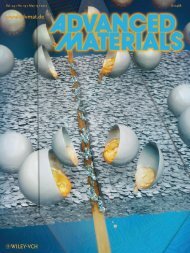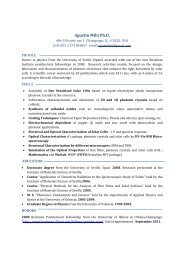Polymer Brushes for Molecular Transport - Paul Braun Research ...
Polymer Brushes for Molecular Transport - Paul Braun Research ...
Polymer Brushes for Molecular Transport - Paul Braun Research ...
Create successful ePaper yourself
Turn your PDF publications into a flip-book with our unique Google optimized e-Paper software.
2.2.4 Self-assembled monolayers (SAMs) <strong>for</strong>mation<br />
Fisherbrand microscope coverslips (22 mm x 22 mm x 0.17 mm) and silicon (100) wafers<br />
(25 mm x 25 mm x 0.5 mm) were cleaned in boiling piranha solution (3:1 v/v mixture of<br />
concentrated H2SO4 and 30% aqueous H2O2 solution) (CAUTION: piranha solutions are<br />
strongly oxidizing and should not be allowed to contact organic solvents.) <strong>for</strong> 3 hours. They<br />
were subsequently rinsed with an excess of Millipore ® water (18.2 MΩ·cm) and dried with<br />
nitrogen.<br />
Monolayers were <strong>for</strong>med by submerging cleaned substrates in hexane solutions of OTS<br />
or CTS (2 mM) <strong>for</strong> one hour. Samples were then sonicated in hexane to remove excess material<br />
from the surface and subsequently rinsed in hexane, ethanol and finally deionized water be<strong>for</strong>e<br />
being dried with nitrogen.<br />
PEG layers were <strong>for</strong>med using the following procedure. 100 mg of silanated PEG 2000<br />
was dissolved in 20 mL of ethanol and 1 mL water; hydrochloric acid was added until a drop of<br />
the solution turns pH paper a color corresponding to a pH of 2. The substrates remained in<br />
solution <strong>for</strong> two days at room temperature and were subsequently rinsed with ethanol and<br />
deionized water and blown dry with nitrogen.<br />
2.2.5 Charaterization of SAMs on silica<br />
Ellipsometry thickness data were collected on the SAMs grafted on silicon wafers. At<br />
632.8 nm (wavelength of incident light), the refractive index and extinction coefficient of the<br />
substrate are 3.85 and -0.02 respectively, and those of the organic layer are assumed to be 1.46<br />
and 0 respectively. The thickness of the native oxide was subtracted from the measured<br />
thickness of the deposited layer.<br />
20




